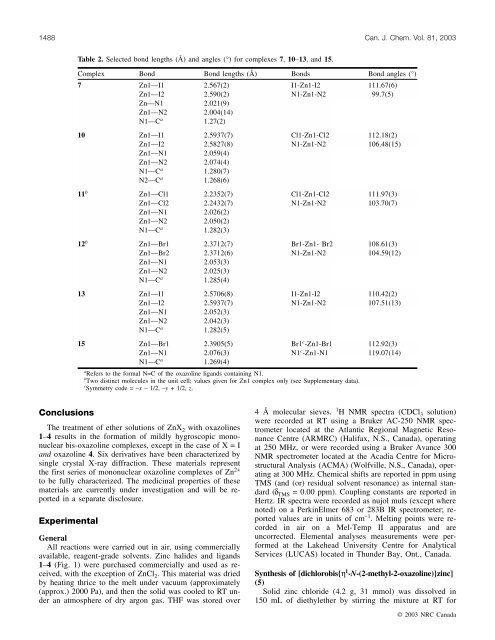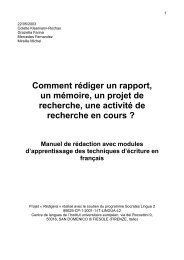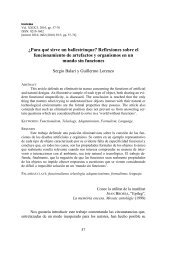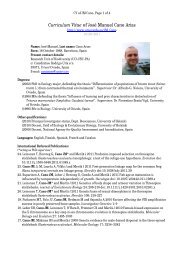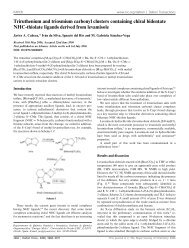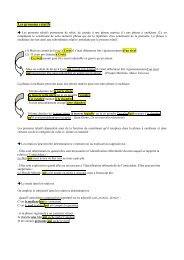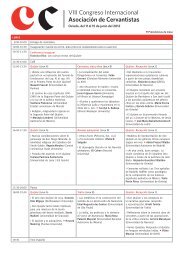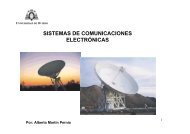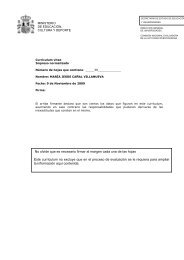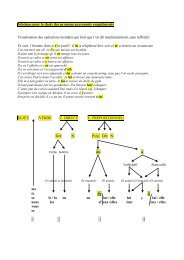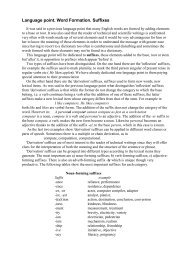Oxazoline chemistry â Part IV: Synthesis and characterization of ...
Oxazoline chemistry â Part IV: Synthesis and characterization of ...
Oxazoline chemistry â Part IV: Synthesis and characterization of ...
Create successful ePaper yourself
Turn your PDF publications into a flip-book with our unique Google optimized e-Paper software.
1488 Can. J. Chem. Vol. 81, 2003<br />
Table 2. Selected bond lengths (Å) <strong>and</strong> angles (°) for complexes 7, 10–13, <strong>and</strong> 15.<br />
Complex Bond Bond lengths (Å) Bonds Bond angles (°)<br />
7 Zn1—I1 2.567(2) I1-Zn1-I2 111.67(6)<br />
Zn1—I2 2.590(2) N1-Zn1-N2 99.7(5)<br />
Zn—N1 2.021(9)<br />
Zn1—N2 2.004(14)<br />
N1—C a 1.27(2)<br />
10 Zn1—I1 2.5937(7) Cl1-Zn1-Cl2 112.18(2)<br />
Zn1—I2 2.5827(8) N1-Zn1-N2 106.48(15)<br />
Zn1—N1 2.059(4)<br />
Zn1—N2 2.074(4)<br />
N1—C a 1.280(7)<br />
N2—C a 1.268(6)<br />
11 b Zn1—Cl1 2.2352(7) Cl1-Zn1-Cl2 111.97(3)<br />
Zn1—Cl2 2.2432(7) N1-Zn1-N2 103.70(7)<br />
Zn1—N1 2.026(2)<br />
Zn1—N2 2.050(2)<br />
N1—C a 1.282(3)<br />
12 b Zn1—Br1 2.3712(7) Br1-Zn1- Br2 108.61(3)<br />
Zn1—Br2 2.3712(6) N1-Zn1-N2 104.59(12)<br />
Zn1—N1 2.053(3)<br />
Zn1—N2 2.025(3)<br />
N1—C a 1.285(4)<br />
13 Zn1—I1 2.5706(8) I1-Zn1-I2 110.42(2)<br />
Zn1—I2 2.5937(7) N1-Zn1-N2 107.51(13)<br />
Zn1—N1 2.052(3)<br />
Zn1—N2 2.042(3)<br />
N1—C a 1.282(5)<br />
15 Zn1—Br1 2.3905(5) Br1 c -Zn1-Br1 112.92(3)<br />
Zn1—N1 2.076(3) N1 c -Zn1-N1 119.07(14)<br />
N1—C a 1.269(4)<br />
a Refers to the formal N=C <strong>of</strong> the oxazoline lig<strong>and</strong>s containing N1.<br />
b Two distinct molecules in the unit cell; values given for Zn1 complex only (see Supplementary data).<br />
c Symmetry code = –x – 1/2, –y + 1/2, z.<br />
Conclusions<br />
The treatment <strong>of</strong> ether solutions <strong>of</strong> ZnX 2 with oxazolines<br />
1–4 results in the formation <strong>of</strong> mildly hygroscopic mononuclear<br />
bis-oxazoline complexes, except in the case <strong>of</strong> X=I<br />
<strong>and</strong> oxazoline 4. Six derivatives have been characterized by<br />
single crystal X-ray diffraction. These materials represent<br />
the first series <strong>of</strong> mononuclear oxazoline complexes <strong>of</strong> Zn 2+<br />
to be fully characterized. The medicinal properties <strong>of</strong> these<br />
materials are currently under investigation <strong>and</strong> will be reported<br />
in a separate disclosure.<br />
Experimental<br />
General<br />
All reactions were carried out in air, using commercially<br />
available, reagent-grade solvents. Zinc halides <strong>and</strong> lig<strong>and</strong>s<br />
1–4 (Fig. 1) were purchased commercially <strong>and</strong> used as received,<br />
with the exception <strong>of</strong> ZnCl 2 . This material was dried<br />
by heating thrice to the melt under vacuum (approximately<br />
(approx.) 2000 Pa), <strong>and</strong> then the solid was cooled to RT under<br />
an atmosphere <strong>of</strong> dry argon gas. THF was stored over<br />
4 Å molecular sieves. 1 H NMR spectra (CDCl 3 solution)<br />
were recorded at RT using a Bruker AC-250 NMR spectrometer<br />
located at the Atlantic Regional Magnetic Resonance<br />
Centre (ARMRC) (Halifax, N.S., Canada), operating<br />
at 250 MHz, or were recorded using a Bruker Avance 300<br />
NMR spectrometer located at the Acadia Centre for Microstructural<br />
Analysis (ACMA) (Wolfville, N.S., Canada), operating<br />
at 300 MHz. Chemical shifts are reported in ppm using<br />
TMS (<strong>and</strong> (or) residual solvent resonance) as internal st<strong>and</strong>ard<br />
(δ TMS = 0.00 ppm). Coupling constants are reported in<br />
Hertz. IR spectra were recorded as nujol muls (except where<br />
noted) on a PerkinElmer 683 or 283B IR spectrometer; reported<br />
values are in units <strong>of</strong> cm –1 . Melting points were recorded<br />
in air on a Mel-Temp II apparatus <strong>and</strong> are<br />
uncorrected. Elemental analyses measurements were performed<br />
at the Lakehead University Centre for Analytical<br />
Services (LUCAS) located in Thunder Bay, Ont., Canada.<br />
<strong>Synthesis</strong> <strong>of</strong> [dichlorobis{η 1 -N-(2-methyl-2-oxazoline)}zinc]<br />
(5)<br />
Solid zinc chloride (4.2 g, 31 mmol) was dissolved in<br />
150 mL <strong>of</strong> diethylether by stirring the mixture at RT for<br />
© 2003 NRC Canada


